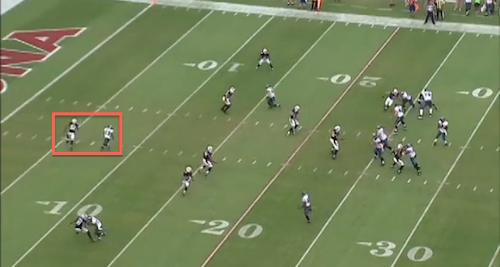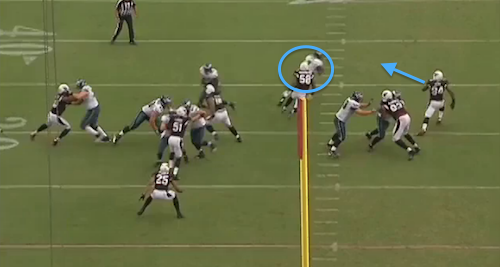All 22: What We Learned About the Eagles’ Offense
Here’s what I saw from the Eagles’ offense after reviewing the All-22 footage from this week.
Before we get started, some overall themes. Number one, the coaches have to take a hit for the game-plan, which was built around the following ideas:
* That DeSean Jackson could get behind the Cardinals’ secondary for big plays.
* That an offensive line with two new guys (Dallas Reynolds and Demetress Bell) would be able to protect Michael Vick well enough to give him time to find receivers way downfield.
* That Vick would hit on the big plays when they were available.
Obviously, not all of those things happened, and hopefully below, you can see why.
Play 1: The Eagles face a 3rd-and-7 from their own 27. They go with an empty backfield as both LeSean McCoy and Brent Celek are split out wide. The Cardinals initially rush three defenders. In the first photo, you can see that the Eagles appear to be set up well to protect Vick here.
Todd Herremans and Danny Watkins are double-teaming Darnell Dockett. Reynolds and Evan Mathis are doing the same on Calais Campbell. And Bell is one-on-one with Sam Acho.
But things change. Campbell (No. 93 in the middle) takes his rush to the right of Reynolds. And Bell gets beat, causing Mathis to shift over to help.
All of a sudden, Reynolds, who is making his first career start, is going one-on-one against Campbell. That didn’t turn out so well.
Vick actually gets rid of the ball here and completes a 20-yard pass, but he also gets crushed by Campbell. Keep in mind, this all takes place in just over two seconds. In other words, there’s nothing Vick can do here to avoid the hit. Troubling, considering the Cardinals do not even bring extra pressure on the play.
Play 2: This one reminded me of what Browns linebacker D’Qwell Jackson said about the Eagles’ run game after Week 1.
“That’s not their identity. They’re a team that likes to pass the ball and occasional screens and draws, but that’s not who they are. We knew that coming into it.”
In other words, even though the Eagles have one of the best running backs in the league in LeSean McCoy, opposing defenses don’t feel the need to game-plan against their rushing attack. Instead, they focus on limiting downfield plays by Jackson and the passing game. They don’t believe the offense can methodically move the ball without turning it over. And they bank on Andy Reid and Marty Mornhinweg getting greedy. Often times, they’re right.
Take a look at the blocking on the play below.
Keep in mind, this is 1st-and-15. It’s not like we’re looking at an obvious passing situation. It’s clear that a run up the middle is the last thing the Cardinals are expecting. Reynolds and Stanley Havili deliver good blocks, and the Eagles pick up 7 yards.
Play 3: Another good run – this one later in the game. Watkins and Herremans both do nice jobs, and McCoy has a huge lane to run through for 14 yards.
Granted, this is in the fourth quarter with the game out of hand. But again, defenses are going to guard against the Eagles’ vertical passing game all game long until they’re given a reason not to. These run plays will continue to be available if the Eagles are willing to take them.
Play 4: It’s important to remember that when the Eagles have pass protection issues, it’s not always just the offensive line. The tight ends and running backs have to do a better job too, especially when Vick is getting blitzed. On this specific play, the Eagles are at their own 9. Linebacker Daryl Washington is going to blitz the A-Gap between Reynolds and Mathis. It’s on McCoy to pick him up.

But he gets there late, and Washington beats him. Vick spins out of the sack initially and avoids a potential safety. But eventually, he’s taken down for a loss of 3.
Play 5: Sometimes, it’s just on the quarterback. Maybe Vick is a bit gun-shy, given his turnover issues, but on this play, he has Jackson and Damaris Johnson open. Rather than getting them the football, he chooses to take off.
A completion probably would have picked up 13 or 14 yards. But Vick holds on to the ball and takes off for a 5-yard gain, absorbing a hit in the process. We should point out that Bell is called for holding on the play, but you get the point.
Play 6: When the Eagles did have opportunities deep, they didn’t capitalize. Here, Jackson clearly has a step and is waving for the ball. But Vick holds on to it and scrambles.
Granted, he picks up 20 yards, but he also takes a hit. Had he delivered on time, the Eagles would have had a good chance for a 35-yard touchdown.
Play 7: On the 1-yard-line, before the game-changing fumble at the end of the first half, here’s what Vick has to work with on first down.
The red circle is Havili. It sure looks like the Eagles have what they want there. He has a defender behind him, and Havili’s route takes him towards the pylon for what could be a touchdown. Would a throw to Havili have carried some risk? Sure. There’s a chance he gets tackled short of the end zone and time runs out in the half. But if the play is designed to have him run that route, shouldn’t he at least be an option? The blue circle is Johnson. While it appears he has some space, that’s probably a more dangerous throw. Vick ended up throwing the ball away.
Play 8: On the very next play, Vick has Clay Harbor wide open in the end zone.
The blue box shows all the space he has to work with. The only person in the rectangle is an official. In other words, Vick would not have had to make a perfect throw. He would have just had to get it somewhere in the vicinity of Harbor, and it’s a touchdown. At worst, it’s an incompletion. But he threw it away again. To be fair, he was pressured on the play, and was likely thinking, Don’t hold on to the ball too long and take a sack. But again, points were left on the field.
Play 9: Another one where it looks like Vick has a receiver open. This time, it’s Johnson over the middle.
This is 3rd-and-9 in the third. Vick has all day, but he doesn’t let it rip, instead opting to take off and run, ending up with a 4-yard gain. The Eagles settle for the field goal.
Play 10: In Week 2, the Patriots had success against the Cardinals with play-action passes. I’m sure the Eagles saw that and felt they could do the same. But they were wrong. Check out the first photo. This play counts on Washington (No. 58), who is unblocked, falling for the play-fake.
He does not. By the time Vick turns around, not only is Washington all over him, but Acho, the outside linebacker is closing in too.
The result is a sack and a loss of 12 yards. Vick had no shot here.
Play 11: One more example of play-action gone wrong. Before Vick has even turned around, Bell is getting beaten.
Vick has to escape the pocket immediately, tries to throw the ball away and is called for intentional grounding.
Play 13: Vick had Avant wide open deep for a potential touchdown in the fourth. But he checked it down to Celek, who got hit, resulting in an incompletion.
Protection is fine, the receiver is open, but Vick doesn’t get him the ball.
As I’ve said in the past, these players are expected to make split-second decisions. It’s easy for me to slow everything down and guess what went wrong. Overall, though, the game-plan relied quite a bit on protection that didn’t always hold up – whether that was the offensive line, the running backs or the tight ends. And when Vick did have time, he didn’t take advantage of opportunities that were available.
Those issues resulted in an offensive disaster for a team that is currently averaging 15.7 points per game, tied for dead-last with the Dallas Cowboys.
Follow Sheil Kapadia on Twitter and e-mail him at skapadia@phillymag.com.


